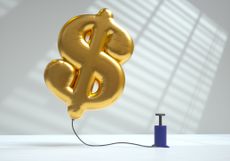Kiplinger Interest Rates Outlook: Still-Strong Inflation Will Delay Fed Rate Cuts
A stronger-than-expected report on March inflation likely will delay the Fed’s first rate cut.

Kiplinger’s Economic Outlooks are written by the staff of our weekly Kiplinger Letter and are unavailable elsewhere. Click here for a free issue of The Kiplinger Letter or to subscribe for the latest trends and forecasts from our highly experienced Kiplinger Letter team.
The March consumer price index report was stronger than expected, sending interest rates higher, as it implied further delay before the Federal Reserve’s first interest rate cut. The lack of progress on inflation means the Fed will not be cutting interest rates until its July 31 meeting at the earliest. If the coming months’ inflation reports don’t improve, the central bank could push off any rate cuts until its Nov. 7 meeting, after the election. The Fed is probably hoping that it will be able to cut in July, because then it could follow a pattern of cutting at every other meeting, which would avoid a cut at its September 18 meeting, during the height of the presidential campaign.
There is still a decent chance of a rate cut this summer. We expect that smaller increases in rents will result in a lower inflation rate for shelter, a major component of the consumer price index. This hasn’t shown up in the CPI report yet, but it should in the near future. Still, the Fed will need to see easing inflation in the next several reports in order to justify a rate cut. While we expect that the April report will show another increase in gasoline prices, the Fed has typically discounted energy price changes. So, the key focus will be on housing and other service prices.

Sign up for Kiplinger’s Free E-Newsletters
Profit and prosper with the best of expert advice on investing, taxes, retirement, personal finance and more - straight to your e-mail.
Profit and prosper with the best of expert advice - straight to your e-mail.
Once the Fed does start cutting interest rates, it will likely continue through 2025, but will not return short-term rates to zero. Figure on the one-month Treasury bill’s yield falling to about 3%, and the bank prime rate ending up around 6%, down from the current 8.5%, after the Fed is finished reducing its benchmark rate.
The Fed could start slowing the rate of reduction in its Treasury securities portfolio at its next meeting on May 1. This would be seen by markets as an initial step toward easing overall monetary policy. This step has been expected for a while, but Powell used the word “soon” at his press conference on March 20. The Fed would effectively increase the number of maturing Treasury securities it purchases as existing bonds mature and roll off its balance sheet. Powell emphasized that it is still the Fed’s goal to reduce the overall amount of Treasuries and mortgage-backed securities on its balance sheet, however. It'll just do so at a slower pace.
The yield on the 10-year Treasury note has risen to near 4.6% but could drift down again whenever monthly inflation reports improve. Until that happens, yields are likely to stay elevated in the mid-to-upper 4s because coming economic reports are likely to point to improving growth.
Mortgage rates won’t be changing much, staying a smidge below 7.0% on average for 30-year fixed loans. After peaking near 8% in October, 30-year fixed-rate mortgages are averaging around 6.9%, while 15-year mortgage rates are averaging about 6.2%. Good inflation reports in the next few months could result in a decline of a few tenths of a point. Mortgage rates typically move with the 10-year Treasury note’s yield, but they are higher than normal now, relative to the Treasury yield. The recent rise in short-term rates has crimped lenders’ profit margins on long-term loans. But eventual Fed cuts in short-term rates will boost banks’ lending margins and should bring some extra reduction in mortgage rates, too.
Other short-term interest rates have risen along with the Federal Funds rate. For investors, rates on super-safe money market funds are above 5%. Rates for borrowers have ticked up, as well. Rates on home equity lines of credit are typically connected to the prime rate (now 8.5%), which in turn moves with the Federal Funds rate. Rates on short-term consumer loans such as auto notes have also been affected. Financing a new vehicle now costs around 7.4% for a six-year loan, and 11.4% for a used vehicle.
Corporate bond rates are moving with changes in long-term Treasury rates. AAA-rated bonds are now yielding around 5%, BBB bonds 5.8%, and CCC-rated bond yields around 13.4%.
Source: Federal Reserve Open Market Committee
Related Content

To continue reading this article
please register for free
This is different from signing in to your print subscription
Why am I seeing this? Find out more here

David is both staff economist and reporter for The Kiplinger Letter, overseeing Kiplinger forecasts for the U.S. and world economies. Previously, he was senior principal economist in the Center for Forecasting and Modeling at IHS/GlobalInsight, and an economist in the Chief Economist's Office of the U.S. Department of Commerce. David has co-written weekly reports on economic conditions since 1992, and has forecasted GDP and its components since 1995, beating the Blue Chip Indicators forecasts two-thirds of the time. David is a Certified Business Economist as recognized by the National Association for Business Economics. He has two master's degrees and is ABD in economics from the University of North Carolina at Chapel Hill.
-
 Is a Phased Retirement Right for You?
Is a Phased Retirement Right for You?Want to keep working, just not as hard? A phased retirement may just be the answer.
By Kimberly Lankford Published
-
 Four Tips to Make Your Sales Presentation a Winner
Four Tips to Make Your Sales Presentation a WinnerBeing prepared and not being boring can go a long way toward persuading a potential customer to buy into what you’re offering.
By H. Dennis Beaver, Esq. Published
-
 How Inflation, Deflation and Other 'Flations' Impact Your Stock Portfolio
How Inflation, Deflation and Other 'Flations' Impact Your Stock PortfolioThere are five different types of "flations" that not only impact the economy, but also your investment returns. Here's how to adjust your portfolio for each one.
By Kim Clark Published
-
 A Spotlight on the Pacific States: The Kiplinger Letter
A Spotlight on the Pacific States: The Kiplinger LetterThe Kiplinger Letter Most Pacific states are seeing good job growth in multiple sectors including tourism, hospitality, and construction.
By David Payne Published
-
 The Robots Are Coming... But Not For a While
The Robots Are Coming... But Not For a WhileThe Kiplinger Letter There’s excitement in the tech sector over the potential of humanoid robots, but widespread adoption is likely to be years away.
By John Miley Published
-
 Farmers Face Another Tough Year As Costs Continue to Climb: The Kiplinger Letter
Farmers Face Another Tough Year As Costs Continue to Climb: The Kiplinger LetterThe Kiplinger Letter Farm income is expected to decline for a second year, while costs continue to up-end farm profitability.
By Matthew Housiaux Published
-
 Kiplinger's Economic Calendar for This Week (April 22-26)
Kiplinger's Economic Calendar for This Week (April 22-26)Check out our economic calendar for this week, as well as our previews and recaps of the more noteworthy reports.
By Karee Venema Last updated
-
 A Spotlight on the Mountain States: The Kiplinger Letter
A Spotlight on the Mountain States: The Kiplinger LetterThe Kiplinger Letter Most Mountain states are seeing good job growth in multiple sectors from healthcare, energy, and semiconductor production to farming and government.
By David Payne Last updated
-
 Why I Still Won't Buy Gold: Glassman
Why I Still Won't Buy Gold: GlassmanOne reason I won't buy gold is because while stocks rise briskly over time – not every month or year, but certainly every decade – gold does not.
By James K. Glassman Published
-
 Should You Use a 25x4 Portfolio Allocation?
Should You Use a 25x4 Portfolio Allocation?The 25x4 portfolio is supposed to be the new 60/40. Should you bite?
By Nellie S. Huang Published